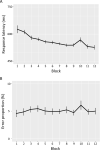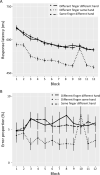Learning a covert sequence of effector movements: limits to its acquisition
- PMID: 37422801
- PMCID: PMC10805866
- DOI: 10.1007/s00426-023-01855-3
Learning a covert sequence of effector movements: limits to its acquisition
Abstract
Sequence learning in serial reaction time (SRT) tasks is an established, lab-based experimental paradigm to study acquisition and transfer of skills based on the detection of predictable regularities in stimulus and motor response sequences. Participants learn a sequence of targets and responses to these targets by associating the responses with subsequently presented targets. In the traditional paradigm, however, actions and response targets are directly related. In contrast, the present study asked whether participants would demonstrate acquisition of a sequence of effector movements of the left vs. right hand (e.g., hand sequence learning), whilst the actual targets and associated finger responses are unpredictable. Twenty-seven young adults performed a SRT task to visually presented characters with the index or middle fingers of both hands. While the specific fingers to respond with were randomly selected for each target presentation, both hands followed a covert sequence. We asked whether participants would learn the underlying hand sequence as demonstrated by shortened response latencies and increased accuracy compared to a fully randomized hand sequence. The results show sequence-specific learning effects. However, categorization of hand responses depending on the previous response suggested that learning occurred predominantly for subsequent finger responses of the same hand, which added to general hand-based priming. Nevertheless, a marginally significant effect was observed even for predictable shifts between hands when homologous fingers were involved. Our results thus suggest that humans are able to benefit from predictable within-hand finger shifts but less so for predicted shifts between hands.
© 2023. The Author(s).
Conflict of interest statement
Both authors declare no financial conflict of interest whatsoever.
Figures


Similar articles
-
Motor sequence learning with the nondominant left hand. A PET functional imaging study.Exp Brain Res. 2002 Oct;146(3):369-78. doi: 10.1007/s00221-002-1181-y. Epub 2002 Aug 24. Exp Brain Res. 2002. PMID: 12232693
-
Asymmetrical intermanual transfer of learning in a sensorimotor task.Exp Brain Res. 2010 May;202(4):927-34. doi: 10.1007/s00221-010-2184-8. Epub 2010 Feb 16. Exp Brain Res. 2010. PMID: 20157699
-
Action observation supports effector-dependent learning of finger movement sequences.Exp Brain Res. 2005 Aug;165(1):19-27. doi: 10.1007/s00221-005-2275-0. Epub 2005 May 10. Exp Brain Res. 2005. PMID: 15883806
-
Segmentation of short keying sequences does not spontaneously transfer to other sequences.Hum Mov Sci. 2009 Jun;28(3):348-61. doi: 10.1016/j.humov.2008.10.004. Epub 2009 Jan 8. Hum Mov Sci. 2009. PMID: 19135276
-
Effector-related sequence learning in a bimanual-bisequential serial reaction time task.Psychol Res. 2008 Mar;72(2):138-54. doi: 10.1007/s00426-006-0097-8. Epub 2006 Nov 8. Psychol Res. 2008. PMID: 17091260
References
-
- Adam JJ, Koch I. Automatic sequential response priming and intentional response preparation in choice reaction tasks: Evidence from response repetition and response cuing. Acta Pathologica, Microbiologica, Et Immunologica Scandinavica. 2009;132(1):48–53. doi: 10.1016/j.actpsy.2009.05.010. - DOI - PubMed
MeSH terms
Grants and funding
LinkOut - more resources
Full Text Sources
Miscellaneous

